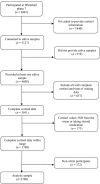Association of diurnal patterns in salivary cortisol with type 2 diabetes in the Whitehall II study
- PMID: 25215558
- PMCID: PMC4255120
- DOI: 10.1210/jc.2014-2459
Association of diurnal patterns in salivary cortisol with type 2 diabetes in the Whitehall II study
Abstract
Context: The hypothalamic pituitary-adrenal axis is thought to play a role in Type 2 Diabetes (T2D). However, the evidence for an association between diurnal cortisol patterns and T2D is equivocal.
Objective: The aim was to examine the association of cortisol patterns throughout the day with T2D status in a community-dwelling population.
Design: This was a cross-sectional study of T2D status and salivary cortisol from phase 7 (2002-2004) of the Whitehall II study, United Kingdom.
Setting: The occupational cohort was originally recruited in 1985-1988.
Participants: Three-thousand, five-hundred eight white men and women including 238 participants with T2D aged 50-74 years with complete information on cortisol secretion participated.
Outcome measures: We measured diurnal cortisol (nmol/L) patterns from six saliva samples obtained over the course of a normal day: at waking, +30 min, +2.5, +8, +12 hours, and bedtime. The cortisol awakening response and slope in diurnal secretion were calculated.
Results: T2D status was associated with a flatter slope in cortisol decline across the day (b = 0.004; confidence interval [CI], 0.001-0.007; P = .014) and greater bedtime cortisol (b = 0.063; CI, 0.010-0.117; P = 0.020) independent of a wide range of covariates measured at the time of cortisol assessment. There was no association between morning cortisol, the cortisol awakening response, and T2D (P > .05).
Conclusions: In this nonclinical population, T2D was associated with a flatter slope in cortisol levels across the day and raised bedtime cortisol values.
Figures
References
-
- Clayton RN, Raskauskiene D, Reulen RC, Jones PW. Mortality and morbidity in Cushing's disease over 50 years in Stoke-on-Trent, UK: Audit and meta-analysis of literature. J Clin Endocrinol Metab. 2011;96(3):632–642. - PubMed
-
- Connell JM, Whitworth JA, Davies DL, Lever AF, Richards AM, Fraser R. Effects of ACTH and cortisol administration on blood pressure, electrolyte metabolism, atrial natriuretic peptide and renal function in normal man. J Hypertens. 1987;5(4):425–433. - PubMed
-
- Phillips DI, Barker DJ, Fall CH, et al. Elevated plasma cortisol concentrations: A link between low birth weight and the insulin resistance syndrome? J Clin Endocrinol Metab. 1998;83(3):757–760. - PubMed
Publication types
MeSH terms
Substances
Grants and funding
LinkOut - more resources
Full Text Sources
Other Literature Sources
Medical


